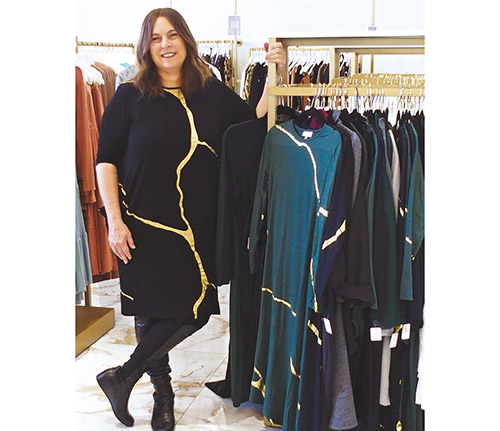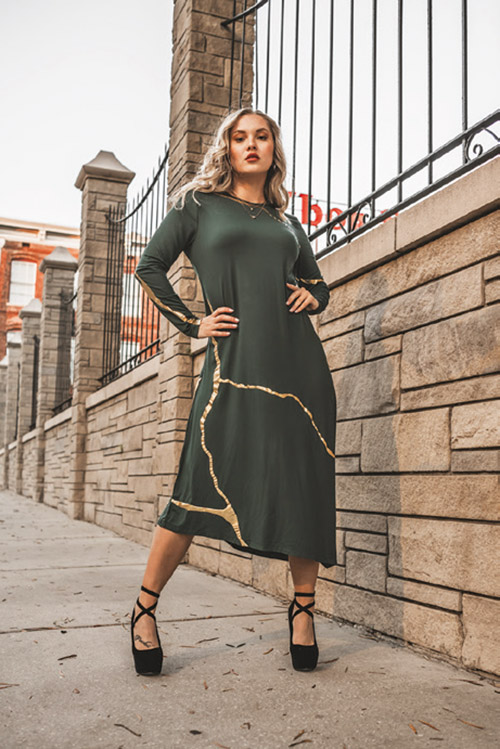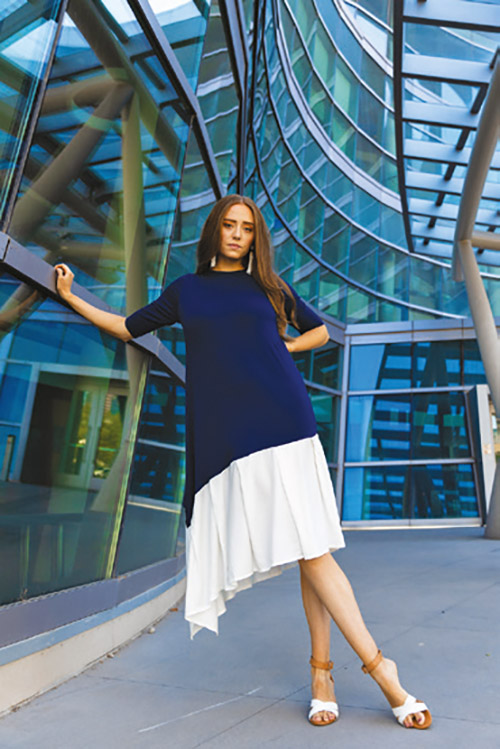
It was the striking, bright gold streaks against the black background of a softly fitted dress that first attracted me to Mikah Fashion on Instagram; like seeing a burst of lightning on a dark night, with just the beauty and no fear. Taking a deeper dive into the collection, I saw the theme repeated in different variations and colors in one- and two-piece styles. There are long maxis and just below-the-knee dress and skirt styles, and a variety of sleeve lengths. Some designs are free flowing, suggesting a relaxed Shabbos evening at home. Others ask to be worn to shul, a business meeting or a date.
After following Mikah Fashion for a while, I saw that the owner/designer, Miriam Grunhaus, was planning a road trip from her Florida home to meet store owners in Baltimore, New Jersey and New York to preview her upcoming winter collection. It was the perfect chance to meet and we got together last month at Flair, in Passaic’s Brook Haven mall.
The gold that caught my eye has a primary and strategic place in Mikah Fashion designs. It is symbolic of the Japanese art of Kintsugi, a method of fixing broken pottery by putting the pieces back together and highlighting the line where the parts are fused back together with gold. Brokenness becomes not a flaw to be disguised but something to be proud of for mending and fixing, making the vessel stronger and more beautiful than before. Miriam learned about Kintsugi when a friend sent her a video about it. The process resonated so much that she researched everything about Kintsugi and incorporated the principles into the fashion design business she had recently started, and into the process of self-healing from a period of adversity she was going through.

Mikah produces two collections annually. The spring collection debuted a month before Pesach. The winter collection being shown to store owners now will be in stores the month before Rosh Hashana.
Mikah’s winter collection includes enhancements on current designs as well as new directions. The gold or silver streaks unfold in different patterns. Some hems are asymmetrical. Grunhaus is introducing new colors, like charcoal with a hint of navy and rich green, with her signature Kintsugi design. Another part of the collection features a more monochrome, casual style, with a draped cowl neck collar and the Mikah Fashion logo that hints at Kintsugi in a more subtle way.
Designs go into production based on a minimum number of orders, with feedback on the designs from the stores, so the final collection is defined by the boutiques’ choices. Grunhaus is also happy to accommodate some changes in the designs that individual store owners request. The road trip was a success, she said. Eight out of 10 stores visited have already placed orders and she is looking forward to visiting more stores in the future.
Grunhaus gets design inspiration from fashion shows and European brands. She creatively absorbs the looks and fuses them into her own creations that adhere to standards of modesty. Unlike many designers, her collection is size-inclusive, from XS to 3XL. “I wanted to serve women of all shapes and sizes,” Grunhaus said. “Our bodies change after having babies, and our needs change as well. I also wanted to serve women with health conditions like fibromyalgia, who have skin sensitivities and need a soft, natural fiber. All women want to look good; we feel empowered and stronger when we feel good about ourselves.”

Grunhaus invested in research about body types, researching Jewish American women whose bodies changed for many reasons including having children. She applied that knowledge to her designs so she could create styles that were flattering. “Not all styles fit well in all sizes,” she said. “For example, we had a cropped vest that for larger sizes we increased the length. We take pride in customizing our designs to get the best fit for most shapes.”
The entrepreneur’s vision is successful due to her control of the manufacturing process. Grunhaus primarily uses viscose, a fabric made from natural sources—pulp from trees. It is soft and comfortable, but pills when the fibers are short. She uses the more expensive long fibers to custom make her fabric in Italy. “The process of adding the (gold and silver) foil is complicated as our fabric is stretchy,” she explained. “You put it in the machine and put on glue that you don’t see. Then you pass it again on a big roll of foil and it sticks to the glue. We are careful not to stretch the fabric so the application is even. Because we print on the roll, the pattern comes out slightly different on each garment so each one is unique, as we are.” Mikah produces the clothing in Portugal using only factories that are fair trade, where the employees earn living wages and are treated with respect, and have the highest standards of cleanliness and quality control.
With all her knowledge, research and creativity, it is surprising to hear Grunhaus say she doesn’t consider herself a fashion designer; fashion is one part of what she does. She has an atypical background. She grew up in Brazil and went to Israel for high school. She then considered law school, but after working in her father’s law practice, she realized law was not for her. An aptitude test led her into the arts, and she took a night course in advertising design, taught by top creative directors from the largest leading advertising agencies such as McCann Erickson and Young & Rubicam. She moved to New York to attend Stern College for Women and the Fashion Institute of Technology. She met her husband on a summer-break trip to Israel, and he moved to New York.
Grunhaus had her own graphic design and marketing firm for 25 years, specializing in creating compliance programs for big pharmaceutical companies. Propelled by adversity, she changed careers to keep her mind occupied. After a short stint with handbag design, she started designing and manufacturing the apparel that is now known for its Kintsugi patterns.

Grunhaus not only incorporated Kintsugi into her fashion designs, she realized the process could help people with their lives. “Kintsugi is a way of living, to accept ourselves with imperfections,” she explained. “The process of healing is the same process as fixing ceramics. There are steps a person has to take to feel whole with their brokenness.” She began interviewing women “thrivers” who overcame their personal tragedies of all different kinds to lead happy, successful lives. She compiled the steps they took into a book, “Heal With Gold: 10 Golden Nuggets to Heal Your Mind and Soul” (www.healwithgold.com). She created a video course which she hopes to release in the future, and coaches people in person and on Zoom to help them achieve their full potential and increase resiliency.
The techniques of Kintsugi are Japanese but Grunhaus’ Judaism is the glue that keeps the foil on the fabric. The name she chose for her company, Mikah, comes from the prayer “Mi Kamocha Hashem,” to recognize that she is not the creator but the vessel, the messenger to bring these ideas into the world. “I want to stay humble,” she said, “and the name reminds me at all times where it all really comes from.”
The complete Mikah collection is available at www.mikahfashion.com. Look for selected pieces of the winter collection mid-August at Flair in Passaic, and other stores in Brooklyn, Monsey, Five Towns and Baltimore.
By Bracha Schwartz












